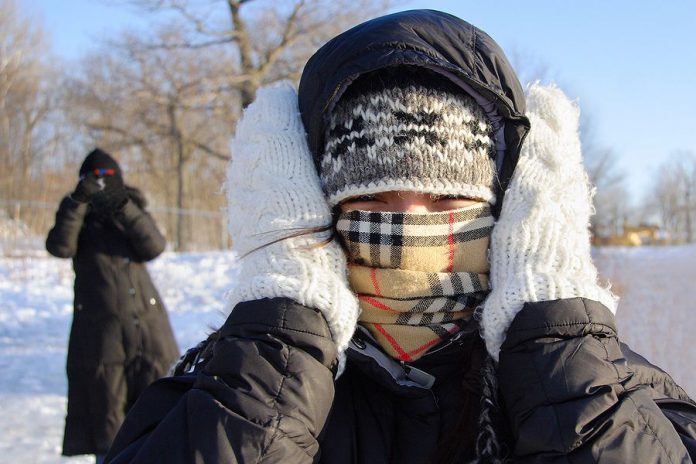After some mild holiday weather, winter has returned with a vengeance just as we head back to school and work. A frigid Arctic air mass has plunged southern Ontario into a deep freeze for this week, with temperatures will below the average values for early January. When combined with high winds, extreme cold can be hazardous or even life threatening.
When the temperature drops below freezing, your body’s extremities (ears, nose, lips, fingers, and toes) lose heat the fastest. Blood vessels close to the skin constrict to keep cold blood from reducing the body’s core temperature. This process happens even faster if the skin is exposed to the wind. The combination of poor circulation and extreme cold can lead to frostbite.
When it’s very cold or after prolonged exposure to the cold, the body is unable to maintain the core temperature — resulting in hypothermia, a very dangerous condition.
Read on to find out more about frostbite and hypothermia, what to do if they happen, and how to prevent them.
Frostbite
There are four degrees of frostbite, from “frostnip” (first degree frostbite) to severe frostbite (third and fourth degree frostbite).
Frostnip is a mild form of frostbite, with superficial cooling of skin tissues without actual damage to the cells. Affected skin appears yellowish or white, but still feels soft to the touch, although you experience painful tingling or burning sensations. When you warm up your frostnipped skin, it might turn red but normal colour returns once the area is warmed. As only the skin’s top layers are affected, frostnip usually does not result in any permanent damage.
With second-degree frostbite, the skin may freeze and harden, but the deep tissues are not affected and remain soft and normal. The skin appears white, feels waxy and hard to the touch, and is numb. The top layers of skin will blister a couple of days after freezing, but most injuries will heal in a few weeks — although the damaged area may become permanently insensitive to both heat and cold.
In severe frostbite, the skin, muscles, tendons, blood vessels, and nerves all freeze. The skin is hard and waxy, without feeling, and use of the area is lost temporarily (and, if untreated, permanently). Deep frostbite results in areas of purplish blisters that turn black. If untreated or if the area becomes infected, severe frostbite can result in the loss of extremities (fingers, toes, ears, and nose).
What to do
- If you can, get out of the cold.
- Don’t rub or massage the affected area; this can result in further damage to the tissue.
- Warm the area gradually using body heat (e.g., a warm hand) or warm water. Never use hot water or apply direct heat; you can burn the skin without realizing it (frostbitten areas often have no sensation).
- Once the affected area is warm, do not re-expose it to the cold.
- Seek medical attention, as soon as possible in cases of severe frostbite.
Hypothermia
Hypothermia is a serious condition with three stages: mild (stage one), moderate (stage two), and severe (stage three).
In stage one, you start shivering, get goose bumps on your skin, and your hands become numb. Your breath can become quick and shallow, and you may feel tired or nauseated. In stage two, your shivering becomes violent, you become uncoordinated and your movements are slow and laboured, and you may become confused. Your lips, ears, fingers and toes may turn blue. In stage three, you’ll stop shivering but you’ll have trouble speaking, thinking, and walking. As your core body temperature continues to fall, you may lose consciousness and your heart may stop.
What to do
Severe cases of hypothermia require immediate medical attention. Call 9-1-1 or your local emergency number. For stage one hypothermia (or while waiting for help for more severe hypothermia):
- Find shelter, out of the cold if possible.
- Keep your muscles moving.
- Remove any wet clothing, dry your skin, and gradually warm your body (wrap yourself in blankets or get in direct skin-to-skin contact with another person).
- If you are helping another person suffering from hypothermia, lay them down and avoid shaking or handling them roughly, particularly if they are unconscious (they may have an irregular heart beat).
Four Steps for Cold Weather Safety
1. Monitor the weather
- Check the weather forecast before heading outdoors.
- Watch for extreme cold warnings from your local health unit. For example, the Peterborough County-City Health Unit issues three levels of notification during extreme cold weather: frostbite alert, frostbite warning, and cold weather emergency.
2. Prepare for the cold
- Wear clothes in layers. The inner layer (closest to the skin) should have “wicking” properties to move any moisture away from the skin. The middle layer should be the insulating layer to prevent loss of your body heat, while keeping the cold outside air away. The outer layer should be the windbreaking layer to reduce the chances of cold air reaching the insulating layer.
- Your body’s extremities are the most susceptible to cold weather, so protect your your ears, cheeks, chin, lips, fingers, and toes by wearing a hat, scarf, neck tube, balaclava, gloves or mittens, and warm and waterproof footwear. This is especially important when there is a wind chill, as exposed skin can freeze in minutes.
- If you’re driving, make sure you have a winter emergency kit in your car, including a fully charged cellphone, ice scraper and snow brush, booster cables, extra clothing and footwear, blankets, windshield washer fluid, bottled water, and high-calorie food (e.g., energy bars).
3. Reduce the effects of the cold
- Limit the amount of time you spend outside.
- When the wind chill is significant, seek shelter out of the wind. If there are no buildings around, look for a small cave, ditch, hollow tree, or a vehicle.
- Stay dry. Wet clothing chills the body rapidly. If you start to sweat, cool off a little by removing outer layers of clothing or open your coat.
- Keep active. Walking or running will help warm you by generating body heat. Keep moving even if you are in shelter, but try to avoid sweating.
4. Be aware
- Watch for signs of frostnip, frostbite, and hypothermia.
- Some people — particularly children, the elderly, and those with circulation problems — are more susceptible to the cold.
- Using alcohol, tobacco and certain medications will increase your susceptibility to cold.



























